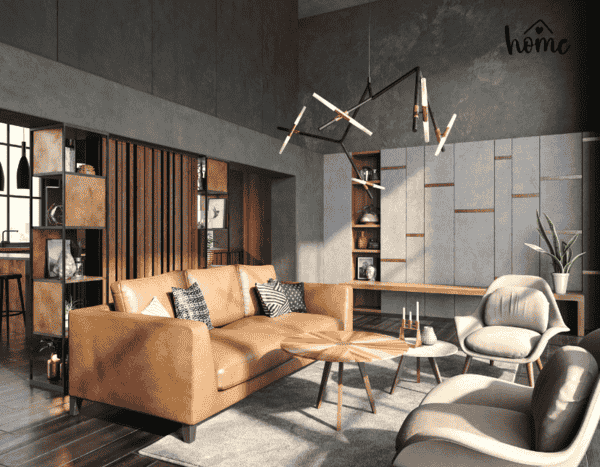Creating a home that truly reflects who you are and how you live is one of the most rewarding challenges homeowners face. Yet traditional interior design often fails to address our personalized lifestyle needs, focusing instead on aesthetics over function.
According to a recent study by HubSpot, 92% of consumers expect personalized experiences based on their specific behaviors and needs, and this extends to our living spaces as well.
This blog offers practical solutions for real-world living, helping you adapt your space with furniture sets for living room and versatile design elements that work with how you actually live.
Read more:
- Why the Details in Your Home Matter More Than You Think
- Supermoms Assemble! How to Maintain Frigidaire Appliances
- Ways To Make Your Home Your Personal Retreat
The Psychology of Lifestyle-Based Home Design
How your environment affects your mental well-being goes deeper than simple aesthetics. The spaces we inhabit can either reduce stress or contribute to it, depending on how well they align with our daily routines.
Creating Stress-Reducing Environments
Your home should serve as a sanctuary that supports your mental health. Cluttered spaces tend to create cluttered minds, while organized environments promote clarity and calm. Consider which elements in your current space might be contributing to stress rather than alleviating it.
Lifestyle Zoning Principles
Lifestyle zoning involves identifying your primary activities and designing designated areas to support them. This might mean creating a meditation corner in your bedroom or a crafting station in your living area. The key is intentional design that serves your specific needs.
Identifying Your Priorities
Take a few minutes to list your top five daily activities at home. Do you work remotely? Love to cook? Host frequent gatherings? Your home should be optimized for these priorities rather than following generic design templates.
With your lifestyle priorities identified, it’s time to explore specific solutions that align your space with how you actually live.
Hack #1: Multi-Functional Furniture Investments
The revolution in transformable furniture has changed how we utilize space in modern homes. These versatile pieces adapt to different needs throughout the day, making them perfect for dynamic lifestyles.
Versatile Couches for Living Room
Today’s couches for living room spaces go far beyond simple seating. Look for options with built-in storage compartments under cushions or in armrests to hide away blankets, remote controls, and other items that tend to create clutter. Sectionals that can be reconfigured based on your needs offer particularly good value.
Nesting Tables and Expandable Dining
Nesting tables provide multiple surfaces when needed, then tuck away compactly when not in use. Similarly, expandable dining tables can accommodate occasional guests without permanently dominating your space.
Murphy Beds and Desk Combinations
These classic space-savers have come a long way in style and functionality. Modern murphy beds often incorporate desks, shelving, or seating that remains accessible when the bed is stowed, making them ideal for studio apartments or guest rooms.
While versatile furniture creates the foundation for a lifestyle-friendly home, strategic zoning takes functionality to the next level. Let’s explore how to create distinct areas that serve multiple purposes without requiring additional square footage.
Hack #2: Strategic Zoning for Mixed-Use Spaces
Creating distinct areas within open floor plans helps train both your brain and body to associate specific spots with particular activities, enhancing focus and enjoyment.
Defining Activity Areas With Small Living Room Furniture
In compact spaces, small living room furniture can do double-duty as zone dividers. Consider a slim console table behind a sofa to create a boundary between living and dining areas. Low bookcases can similarly partition spaces while providing storage.
Room Divider Alternatives
Traditional folding screens aren’t your only option for dividing space. Consider hanging fabric panels, installing sliding doors on tracks, or using tall plants to create visual separation without blocking light.
Color-Coding for Visual Separation
Different color palettes can psychologically define zones without physical barriers. Try using complementary colors or varied intensities of the same color family to distinguish areas dedicated to different activities.
With your floor space efficiently zoned, it’s time to look up. The often-overlooked vertical dimension offers tremendous potential for enhancing your lifestyle.
Hack #3: Vertical Solutions to Maximize Floor Space
Wall space represents some of the most underutilized real estate in most homes. By thinking vertically, you can free up valuable floor space while keeping necessities accessible.
Wall-Mounted Storage Systems
Modular wall systems allow you to customize storage according to your specific needs. Look for adjustable options that can evolve as your storage requirements change over time.
Floating Shelves and Suspended Options
Floating shelves create storage without the visual weight of traditional bookcases. In kitchens, consider hanging pots and utensils from ceiling-mounted racks to free up cabinet space.
Vertical Gardens for Plant Lovers
If you love houseplants but lack surface space, wall-mounted planters and hanging systems let you enjoy greenery without sacrificing precious counter or floor space.
Having maximized your physical space vertically, let’s integrate technology to make your daily routines smoother and more intuitive. These smart solutions act as the invisible infrastructure supporting your lifestyle needs.
Hack #4: Technology Integration That Simplifies Daily Life
Smart home features should enhance your routines rather than simply adding complexity. Focus on tech that solves actual problems in your daily life.
Smart Upgrades
Rather than adopting every new gadget, focus on technologies that address specific pain points in your routine. Smart thermostats that learn your schedule or motion-activated lights in high-traffic areas offer practical benefits beyond novelty.
Hidden Charging Stations
Cable clutter can quickly undermine even the most beautiful space. Consider furniture with built-in USB ports or dedicated charging drawers that keep devices and their cables out of sight.
Voice-Activated Systems
Voice control can be particularly valuable for busy households, allowing you to adjust lighting, music, or temperature without interrupting what you’re doing. This hands-free functionality is especially useful in kitchens and entryways.
While technology enhances functionality, thoughtful lighting transforms the atmosphere of any space. Let’s illuminate how different lighting strategies can instantly adapt your home to support various activities throughout the day.
Hack #5: Lighting Design for Different Activities
The right lighting dramatically affects how we use and experience a space. A thoughtful lighting plan includes multiple layers of illumination that can be adjusted based on the time of day and activity.
Adaptable Lighting Systems
Furniture sets living room arrangements should include varied lighting sources at different heights. Consider floor lamps for reading, table lamps for ambiance, and ceiling fixtures for overall illumination.
Strategic Task Lighting
Identify where you perform detail-oriented tasks like reading, cooking, or crafting, and ensure those areas have dedicated, adjustable lighting that reduces eye strain.
Smart Lighting Solutions
Even on a budget, affordable smart bulbs allow you to program lighting scenes for different activities or times of day. Many systems can be controlled through smartphone apps or voice commands.
Just as lighting shifts to accommodate different activities, your entire home can evolve with the changing seasons. These rotation systems ensure your space remains perfectly aligned with your needs year-round.
Hack #6: Seasonal Rotation Systems
Your home should adapt to seasonal changes in both weather and activities, shifting to accommodate indoor entertaining in winter or outdoor living in summer.
Storage Solutions for Off-Season Items
Develop a system for storing seasonal items when not in use. Vacuum bags can compress bulky winter bedding during summer months, while under-bed containers can house off-season clothing.
Modular Furniture Arrangements
Furniture sets living room configurations can be rearranged seasonally to optimize for different activities. In winter, group seating is closer to promote conversation, while summer arrangements might prioritize airflow and connections to outdoor spaces.
Quick-Change Décor Elements
Keep a selection of seasonally appropriate textiles like throw pillows, blankets, and even artwork that can be swapped out quarterly to refresh your space without major investments.
Beyond the visual elements that adapt to seasonal changes, the auditory environment profoundly impacts your daily experience. Let’s explore how thoughtful sound management creates harmony in multi-functional spaces.
Hack #7: Sound Management for Work-From-Home Success
In homes that double as workspaces, managing acoustics becomes essential for productivity and mental well-being.
Noise-Reducing Design Elements
Home décor ideas should include sound-absorbing materials like textiles, rugs, and soft furnishings that reduce echo and absorb background noise.
Creating Quiet Zones
Designate specific areas as quiet zones with proper sound insulation. Room dividers with acoustic panels can create effective boundaries in shared spaces.
Acoustic Furniture Options
Look for furniture with built-in acoustic properties, such as high-backed sofas that can act as sound barriers or upholstered headboards that absorb noise.
Creating acoustic balance protects your productivity, and similarly, the next strategies safeguard your style while accommodating the youngest members of your household. Family-friendly doesn’t have to mean design compromise.
Your Most Common Questions About Home Adaptability
How can I make my small living room look bigger without sacrificing comfort?
Use living room couches with exposed legs to create a sense of openness, incorporate mirrors to reflect light, and choose multi-functional pieces that eliminate the need for excess furniture. Light colors on walls and strategic lighting also create the illusion of more space.
What furniture arrangements work best for homes with multiple remote workers?
Create dedicated work zones with good lighting and sound control. Use space-saving furniture like drop-leaf desks or console tables that can transform into workstations, then fold away after hours. Room dividers or bookcases can establish visual boundaries between work areas.
How do I create a cohesive look while incorporating multi-functional pieces?
Choose a consistent color palette and material themes that unify your space-saving furniture throughout the home. Stick with complementary styles and repeat certain design elements like specific hardware finishes or fabric patterns to create visual connections between different functional pieces.
Making Your Space Work For You
Creating a truly personalized home isn’t about following design trends or spending extravagantly on new furniture. It’s about thoughtfully assessing how you live and making intentional choices that support those activities. By implementing even a few of these hacks, you can transform your living space into a place that actively enhances your daily experience rather than just looking nice in photographs.
Remember that your home should evolve as your life does. The most successful spaces are those that can adapt to changing circumstances while continuing to support your core values and activities.

